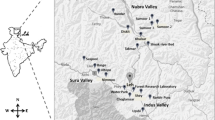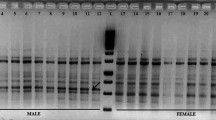Abstract
In many dioecious plants, gender affects economic value, breeding schemes and opportunities for commercial harvests. Hippophae rhamnoides L. is a dioecious plant species in which female genotypes are commercially preferred over male genotypes. Its berries have rich medicinal, nutritional and pharmaceutical properties because of their large amounts of vitamins, essential oils, proteins, fatty acids, free amino acids and flavanoids. Primary limitation for breeding H. rhamnoides L. is its dioecious nature, since gender cannot be identified by traditional methods. Therefore, some reliable and quick methods need to be developed. This communication deals with the development of isozyme and RAPD markers for early sex identification in this dioecious tree. The isozyme analysis was conducted with four enzyme systems, viz. peroxidase, esterase, malate dehydrogenase and catalase. The peroxidase enzyme system produced a female specific sex marker, which successfully differentiated between the staminate and pistillate genotypes of H. rhamnoides L. Thirty five random decamer primers were used in our study and one male sex linked marker was identified. OPD-20 (5′-ACTTCGCCAC-3′) displayed a band at 911 bp that expressed polymorphism between male and female genotypes. The staminate and pistillate genotypes could be distinguished using RAPD marker OPD-20911. These results revealed the immense potential of peroxidase isozyme patterns and RAPD as genetic markers for sex identification in H. rhamnoides L.
Similar content being viewed by others
References
Aggarwal V, Sharma K, Gupta S, Kumar R, Parsed M. 2007. Identification of sex chromosome in Simmondsia chinensis (Jojoba) using RAPD markers. Plant Biotechnol Rep, 1: 207–210
Alstrom R C, Lascoux M, Wang Y C, Roberts G, Tiskan G A. 1998. Identification of a RAPD marker linked to sex determination in the basket willow (Salix viminalis L.). J Hered, 89: 44–49
Banerjee N S, Manoj P, Das M R. 1999. Male sex associated marker in Piper longum L. Curr Sci, 77: 692–695
Buhatel T, Vesa S, Morar R. 1991. Data on the action of seabuckthorn oil extract in cicatrization of wounds in animals. Buletinulinstituhii Agronomic Chij Napoea Seria Zootohnic Si Medicina Veterinaria, 45: 129–133
Chen J H. 1991. Effect of the immuno modulating agents (BCG) and the juice of HRL in the activity of splenic NK cells and LAK cells from tumour bearing mice. Chin J Microbiol Immunol, 11: 105–108
Conkle M T. 1981. Isozyme variation and linkage in some conifer species. In: Conkle M T (ed). Proceeding Symposium of Isozymes: North America Forest Trees and Forest Insects. Berkly. California: Gen Tech Rep, PSW-48
Davies J. 1964. Disc electrophoresis II. Methods and application of human serum proteins. Ann New York Acad Sci, 121: 404–427
Doyle J J, Doyle J. 1987. A rapid DNA isolation procedure from small quantities of fresh leaf tissue. Phytochem Bull, 19: 11–15
Ganeshaiah K N, Ravishankar K V, Anand L, Shibhu M P, Shaanker U. 2002. Identification of sex specific DNA markers in the dioecious tree, nutmeg (Myristica fragrans Houtt.). PGR News Letter, 121: 59–61
Georg J, Karun A, Manimekali R, Rajesh M K, Remya P. 2007. Identification of RAPD marker linked to sex determination in palmyrah (Borassus flabellifer L.). Curr Sci, 93: 1075–1077
Hirsch A M, Fortune D, Chalak L, Lagave J M, Chat J, Monet R. 1997. Peroxidase test: A test for sex screening in kiwifruit seedlings. Acta Horticult, 444: 89–95
Hormaza J L, Dollo, Polito V S. 1994. Identification of RAPD marker linked to sex determination on Pistachoio vera using bulk segregant analysis. Theor App Genet, 89: 9–13
Jeppsson N. 1999. Genetic variation and fruit quality in Seabuckthorn and black chokeberry. Doctoral Thesis. Kristianstad, Sweden: Swedish University of Agricultural Sciences
Kahlem G. 1976. Isolation and localization of histoimmunology of isoperoxidase specific for male flowers of dioecious species Mercurialis annua. Dev Biol, 50: 58–67
Lbeda A. 2003. Danube Seabuckthorn populations, valuable for selections. In: Singh V, Khosla P K (eds). Proceedings of International Workshop on Seabuckthorn. New Delhi, 8–21
Lee T T. 1973. Extraction and quantification of plant peroxidase isoenzymes. Physiol Plants, 29: 198–203
Legrnand B, Bouazza A. 1991. Changes in peroxidase and IAA-oxidase activities during adventitious bud formation from small root explants of Cichorium intybus L.: Influence of glucose. J Plant Phys, 138: 102–106
Ornstein L. 1964. Disc electrophoresis I. background and theory. Ann New York Acad Sci, 121: 321–349
Persson H A, Nybom H. 1998. Genetic sex determination and RAPD marker segregation in the dioecious species, seabuckthorn (Hippophae rhamnoides L.). Hered Land, 129: 45–51
Ruan C J, Li D Q. 2000. Function and benefits of seabuckthorn improving eco environment of loess plateaus. Environ Prot, 5: 30–31
Ruan C J, Xie Q L. 2001. Preliminary report on seabuckthorn variety introduction at beach in Vancheng City. Hippophae, 14: 15–19
Scandalios J G. 1969. Genetic control of multiple molecular forms of enzymes in plants: a review. Biochem Genet, 3: 37–79
Shaw C R, Prasad R. 1970. Starch gel electrophoresis of enzymes: a compilation of recipes. Biochem Genet, 4: 297–320
Shirkot P. 2000. Studies on sex and cultivar identification of Actinidia deliciosa through molecular markers. Doctoral Thesis. Solan, H. P., India: Dr. Y.S. Parmar University of Horticulture and Forestry
Shirkot P, Sharma D R, Mohapatra T. 2002. Molecular identification of sex in Actinidia deliciosa var. deliciosa by RAPD markers. Sci Hort, 94: 33–39
Singh M, Kumar S, Singh A K, Kalloo G. 2002. Female sex associated marker in pointed ground (Trichosanthes dioica Roxb.). Curr Sci, 82: 131–132
Singh V. 1998. Seabuckthorn: a wonder plant of dry temperate Himalayas. Indian Horticult, 6–9
Synge P M. 1974. Dictionary of Gardening: A Practical and Scientific Encyclopaepedia of Horticulture. 2nd ed. Oxford: Clarendon Press
Walf D, Wegart F. 1993. Experience gained in the harvesting and utilization of seabuckthorn. In: Cultivation and Utilization of Wild Fruit Crops. Germany: Ernhard Thalacker veriage Gmbh & Co., 22–29
Williams J G K, Kubelik A R, Livak K J, Rafalski J A, Tingsey S V. 1990. DNA polymorphism amplified by arbitrary primers are useful as genetic markers. Nucl Acid Res, 18: 6531–6535
Author information
Authors and Affiliations
Corresponding author
Rights and permissions
About this article
Cite this article
Sharma, A., Zinta, G., Rana, S. et al. Molecular identification of sex in Hippophae rhamnoides L. using isozyme and RAPD markers. For. Stud. China 12, 62–66 (2010). https://doi.org/10.1007/s11632-010-0012-7
Received:
Accepted:
Published:
Issue Date:
DOI: https://doi.org/10.1007/s11632-010-0012-7




